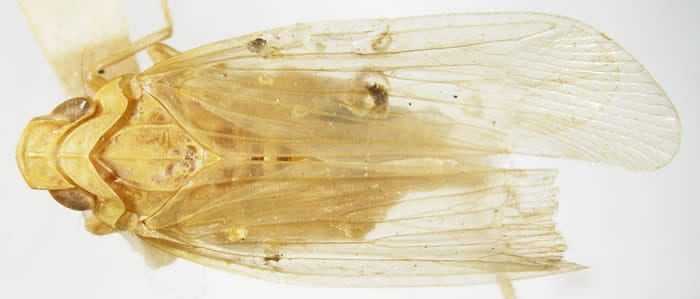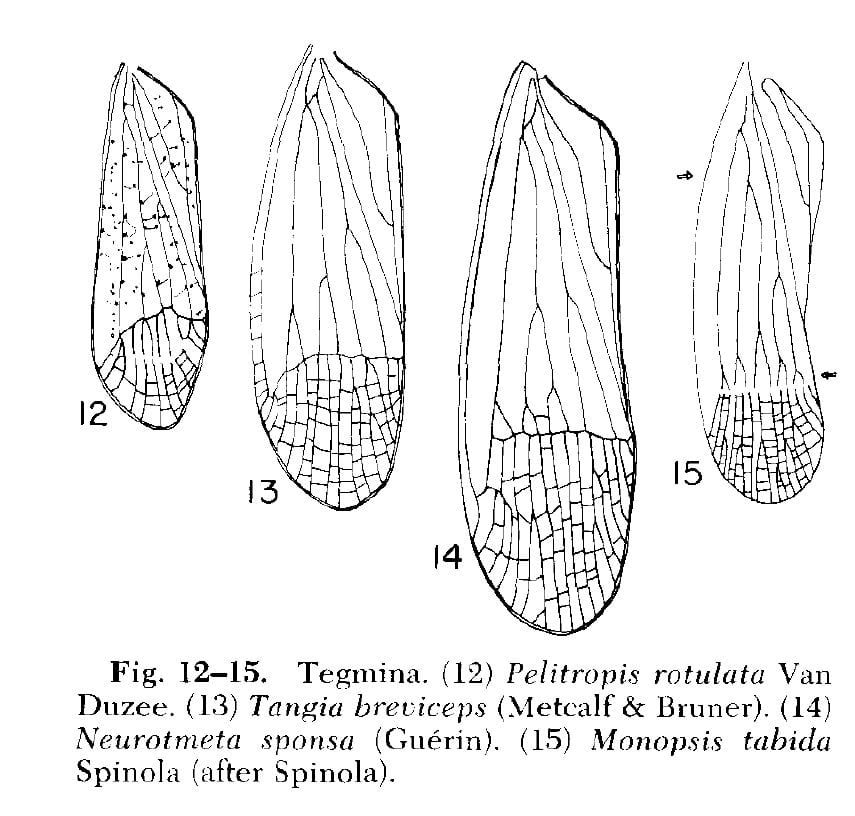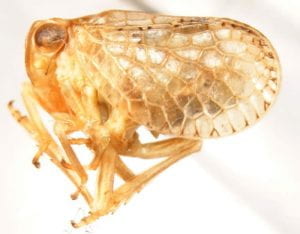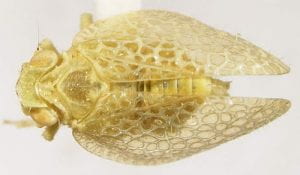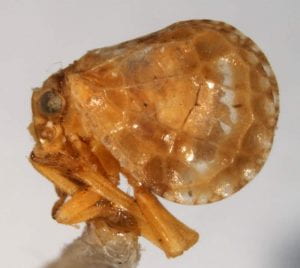
Pelitropis rotulata (Tangiini) from North Carolina (photo by Kimberley Shropshire, University of Delaware, Department of Entomology)
Tropiduchidae is a relatively small, advanced planthopper family consisting (as currently defined) of 196 genera and 673 species (Bourgoin 2020). Tribes of Tropiduchidae were revised by Fennah (1982), and these were implicitly placed in the subfamilies of Metcalf (1954). The recent investigation of the relationships and composition of higher planthoppers has resulted in the transfer of taxa into Tropiduchidae, including Gaetuliina (from Nogodinidae, Bladinini; originally in Issidae) and Trienopinae (transferred from Acanaloniidae, originally in Issidae) (Gnezdilov 2007). Gnezdilov (2013) has revised the higher classification of Tropiduchidae. Gnezdilov (2013) divided the Tropiduchidae into two subfamilies, the ‘traditional’ Tropiduchidae – the Tropiduchinae – consisting of flattened forms usually with a nodal flexion in the tegmina with distal reticulate venation; and the ‘non-traditional’ Tropiduchidae – the Elicinae – consisting of ‘issid-like’ forms segregated out of (e.g.) the Issidae and Acanaloniidae.
Similar to other advanced families of planthoppers, Tropiduchidae has the teeth on the second tarsomere of the hind leg reduced to a lateral pair. Tangiini and Remosini tend to be flattened with a distinct nodal line on the wing, with the venation reticulate distad of the nodal line. Some Tropiduchidae superficially resemble dictyopharinae dictyopharids, but are readily separated by the distinct nodal line and the lack of intermediate carinae on the frons. The Elicinae, which in the US consist of issid-like taxa formerly in the Gaetuliini (of Nogodinidae, now a synonym of Elicini), are similar to Issidae, and both have 1-4 lateral spines (usually 2-3, but 1 in Osbornia cornuta and some Dictyssa, and 4 in Danepteryx and Misodema) on the hind tibiae and wings (usually) covering the abdomen. They can be separated by having reticulate venation (shared with the issids Paralixes and Traxus) with some cells membranous.
North American Tropiduchidae as traditionally defined (i.e., Tangiini and Remosini among U.S. taxa) were reviewed by O’Brien (1992) and are represented in the United States by 2 species in 2 genera (Pelitropis rotulata and Tangia breviceps) from the southeast, with two other species (Monopsis tabida and Neurotmeta sponsa) reported but unverified by specimens (O’Brien 1992). Spinola (1839: 302-304) described Monopsis tabida from “Des États-Unis de l’Am.-Sept.”, subsequently (Uhler 1884, Swezey 1904, Van Duzee 1908) annotated as Florida, but this species was not confirmed from the United States (O’Brien 1992). Neurotmeta sponsa was reported from southern Florida by Uhler (1884) (described from Cuba) but also was not confirmed from the U.S. (O’Brien 1992). All 4 of these genera have additional species in the Neotropics.
The Elicinae (Elicini; sensu Gnezdilov 2007, 2013) (formerly Gaetuliini) includes 10 genera and 62 species north of Mexico, all of which are southwestern, with 8 genera and 55 species from California. Only 1 species in this tribe, Misodema dubia Caldwell, 1945, has not been reported north of Mexico. Gaetuliini was moved from Issidae to Nogodinidae by Fennah (1984, as a subtribe of Bladinini), following his review of nogodinid higher classification (Fennah 1978). Emeljanov (1999) agreed with Fennah’s (1984) placement of the tribe; however, Gaetuliini did not group with Nogodinidae in the molecular phylogeny of Urban and Cryan (2007). Subsequently, Gaetuliini were transferred to Tropiduchidae by Gnezdilov (2007), then subsumed under the Elicini (Gnezdilov (2013). Dictyssonia beameri was not treated by Fennah (1954), but appears to be closely allied with Gaetuliini, and is treated as such here. Therefore, as currently defined, Tropiduchidae north of Mexico consists of 12 genera and 64 species.
Gaetuliini was included within Doering’s revision of Issidae (Doering 1936, 1938, 1940, and 1941), which should be consulted for the identification of these species. O’Brien (1988) presented an updated version of Doering’s (1938) key that includes Gaetuliini, Issidae, Caliscelidae, and Euthiscia (now Philatis; Acanaloniidae).
The majority of tropiduchids are found on above-ground portions of woody dicots (Wilson et al. 1994). Wilson & Wheeler (1984) record Pelitropis rotulata from 19 woody host plants and described immatures. This species appeared to be univoltine in North Carolina. Tangia breviceps has been recorded from Cocoloba uvifera (O’Brien 1992) and Neurotmeta sponsa from guava and coffee (Metcalf & Bruner 1930, Fennah 1982). Life history has not been studied in detail for any Gaetuliini. They feed mostly on shrubs, particularly from the Asteraceae, Rosaceae, and Ericaceae (Wilson et al. 1994).
I have an overview of the classification for Tropiduchidae here.
Synopsis of the Tropiduchidae (sensu Gnezdilov 2007) of the New World, Links to taxa reported North of Mexico
Tropiduchinae (sensu Gnezdilov 2013; was Tambiniinae Kirkaldy, 1907)
Remosini Fennah, 1982
Monopsis Spinola, 1839 (Type species Monopsis tabida Spinola, 1839).
Neurotmeta Guérin-Méneville, 1856 (Type species Fulgora sponsa Guérin-Méneville, 1856).
= Tangia Stål, 1859 (Type species Monopsis viridis Walker, 1851); syn. by Van Duzee 1917b: 739; removed from syn. by Fennah 1965a: 100.
[Mesoamerican and Neotropical genera in Remosini]
Neurotmeta Guérin-Méneville, 1856 (Monotypic, type species Fulgora sponsa Guérin-Méneville, 1856) (Caribbean)
Pseudotangia Metcalf 1938: 382 (Monotypic, Pseudotangia sponsa Metcalf, 1938) [Jamaica]
Remosa Distant 1906: 355 (type species Dictyophora cultellator Walker, 1858) (4 species, Caribbean)
Rotunosa Distant, 1906 (type species Dictyophora indicanda Walker, 1858) (4 species, Caribbean, Mesoamerica, South America)
Vanuoides Metcalf, 1938 (monotypic, type species Vanuoides pallescens Metcalf, 1938) [Panama]

Remosa cf cultellator (it is likely to be this species but I have not confidently excluded the other 3 species in the genus)
Tangiini Melichar, 1914
Subtribe Neotangiina Fennah, 1982
Pelitropis Van Duzee, 1908 (Type species Pelitropis rotulata Van Duzee, 1908).
[Other genera in subtribe; all Neotropical, Caribbean or Mesoamerican]
Aripoa Fennah, 1945 (Type species Aripoa silvana Fennah, 1945; 2 species; Guyana & Trinidad)
Dictyotangia Fennah, 1945 (Monotypic, Dictyophara emarginata Uhler, 1895; St. Vincent)
Dioxyomus Fennah, 1945 (Type species Tangidia uhleri Muir, 1931; 4 species Caribbean)
Neotangia Melichar, 1914 (Type species Neotangia angustata (Uhler, 1895); 4 species, Caribbean)
Tangidia Uhler, 1895 (Type species Tangidia alternata Uhler 1895; 5 species, Caribbean)
Subtribe Tangiina Melichar, 1914
Tangia Stål, 1859 (Type species Monopsis viridis Walker, 1851).
[Other genera in subtribe; all Neotropical, Caribbean or Mesoamerican]
Ladella Stål, 1859 (type species Ladella pallida (Walker 1851) ; 2 species; Cuba and Jamaica)
Ladellodes Fennah, 1965 (Type species Ladellodes stali (Fennah, 1949) ; ? 2 species Puerto Rico & St. Thomas)
Tangella Metcalf & Bruner, 1930 (type species Tangella kraatzi (Stal 1859); 5 species Caribbean)
Tambiniini Kirkaldy, 1907
Kallitaxila Kirkaldy, 1901 (Type species Taxila granulata Stål, 1870; 16 species, Old World but the type species established in Hawaii and is a common interception at US ports)
Athestia Melichar, 1914 (Type species Athestia elongata Melichar, 1914) [4 species Mesoamerica]
Alcestini Melichar, 1914
Alcestis Stal 1862: 11 (type species Alcestis pallescens Stål, 1862; 9 species, Neotropical)
Alcumena Schmidt 1932: 37 (monotypic, Alcestis surinamensis Schmidt, 1911; Neotropical)
Alphesiboea Schmidt 1932: 37 (Type species Alcestis similis Schmidt, 1911; 6 species, Neotropical)
Cyphoceratopini Fennah, 1945
Achilorma Metcalf & Bruner, 1930 (Monotypic, type species Achilus bicinctus Spinola, 1839; Mesoamerica
Amaclardea Muir, 1931 (Monotypic, Amaclardea gowdeyi Muir, 1931; Jamaica)
Amapala Melichar, 1914 (type species Amapala ornata Melichar, 1914; 2 species Mesoamerica)
Arenasella Schmidt, 1932 (type species Arenasella rubrovittata Schmidt, 1932; 4 species Neotropical and Mesoamerica)
Chasmacephala Fennah, 1945 (type species Chasmacephala pluvialis Fennah, 1945; 3 species caribbean)
Colgorma Kirkaldy, 1904 (type species Achilus dilutus Stål, 1859; 4 species; Neotropical and Cuba)
Cyphoceratops Uhler, 1901 (monotypica, Cyphoceratops furcatus Uhler, 1901; Cuba and Haiti)
Dichoneura Lethierry, 1890 (monotypica, Dichoneura simoni Lethierry, 1890; Venezuela)
Grynia Stål, 1862 (monotypic, Grynia nigricoxis Stål, 1862; Mexico)
Neorudia Fennah, 1945 (monotypic, type species Rudia proxima Fowler, 1904; Mesoamerica)
Parahydriena Muir, 1924 (Monotypic, type species Parahydriena hyalina Muir, 1924; Puerto Rico & Dominican Republic)
Tangiopsis Uhler, 1901 (Monotypic, Tangiopsis tetrastichus Uhler, 1901; Haiti and Dominican Republic)
Tangyria Uhler, 1901 (Monotypic, Tangyria frontalis Uhler, 1901; Haiti)
Ubis Fennah, 1945 (monotypic, Type species Rudia verticalis Fowler, 1904; Guatemala)
Elicinae Melichar, 1915 (sensu Gnezdilov 2013)
Tribe Bucini Gnezdilov, Bartlett & Bourgoin, 2016
Buca Walker, 1858 (3 species, Neotropical)
Tribe Elicini Melichar, 1915 (was Gaetuliini Fennah, 1978) (sensu Gnezdilov 2007, 2013)
Acrisius Stål, 1862 (= Cadrela Signoret, 1861, 5 species, Brazil, &?)
Danepteryx Uhler, 1889 (Type species Danepteryx manca Uhler, 1889).
= Epidanepteryx Bliven 1966: syn. by O’Brien 1988: 867.
Dictyssonia Ball, 1936 (Type species Dictyssonia beameri Ball, 1936).
Dictyobia Uhler, 1889 (Type species Dictyobia permutata Uhler, 1889; jr. syn. of Hysteropterum semivitreum Provancher, 1889).
Dictyonia Uhler, 1889 (Type species Dictyonia obscura Uhler, 1889).
Dictyonissus Uhler, 1876 (Type species Dictyonissus griphus Uhler, 1876).
Dictyssa Melichar, 1906 (Type species Dictyssa areolata Melichar, 1906).
Dyctidea Uhler, 1889 (Type species Dyctidea angustata Uhler, 1889).
= Dictydea Uhler, 1889: 37; missp. by Uhler 1889: 39; Van Duzee 1938: 33; Doering 1938: 449; 1939: 88; O’Brien 1986: 68; 1988a: 868.
Gaetulia Stål, 1864 (9 species, old and new world, type species Ricania plenipennis Walker, 1858 from Mexico)
Misodema Melichar, 1907 (Type species Misodema reticulata Melichar, 1906 as Rileya reticulata Melichar, 1906); replacement name for unavailable Rileya Melichar, 1906).
= Rileya Melichar, 1906 (nec. Huene 1902).
Neaethus Stål, 1861b (Type species Hysteropterum vitripenne Stål, 1854).
=Issovarcia Bliven, 1966; syn. by O’Brien 1988a: 867.
Nubithia Stål, 1859 (= Distichoptera Brèthes, 1913; 4 species, [temperate?] south america)
Osbornia Ball, 1910 (Type species Osbornia cornuta Ball, 1910).
Key to U.S. Tropiduchidae (Tangiini & Remosini, from O’Brien, 1992).
1. Median carina of frons absent; veins of forewings spotted with brown, lateral fields of pronotum narrower than medial fields…. Pelitropis rotulata Van Duzee
1.’ Median carina of frons present; veins of forewings not spotted with brown, lateral fields of pronotum about as wide as median fields …. 2
2. Vertex longer than broad …. 3
2.’ Vertex broader than long…. Tangia breviceps M&B
3. Forewings with M forking 1/3 from the base (not verified in U.S.) …. Monopsis tabida Spinola
3.’ Forewings with M forking at level of or behind Cu fork (not verified in U.S.) …. Neurotmeta sponsa (Guérin-Méneville)
Neurotmeta viridis from Guana Island, BVI
Tropiduchidae: Tangiini & Remosini. Tangia breviceps (top, Martin Co., Florida), Monopsis tabida (I think from Cuba), Neurotmeta viridis (top, Guana Island, BVI), and Kallitaxila granulata (bottom, Oahu, Hawaii) (photos by Kimberley Shropshire, Dept. Entomology, University of Delaware).
Key to Tropiduchidae (Elicinae) north of Mexico (draft)
1. Forewing short, leaving several abdominal segments exposed from above … (in part) Osbornia Ball
1.’ Forewing reaching or exceeding end of abdomen …. 2
Osbornia (left), Daneopteryx (middle), and Dyctidea (right)
2. Forewing strap-like, much longer than wide; ventral half of abdomen evident in lateral view …. 3
2.’ Forewing wider; abdomen hidden, or mostly hidden, by the wing in lateral view …. 4
3. Vertex much wider than long, head not projecting; 1-3 lateral spines on hind tibiae … Dyctidea Uhler
3.’ Vertex nearly as long as wide, head projecting anteriorly in lateral view; 4 lateral spines on hind tibiae … Danepteryx Uhler
4. Forewing nearly as wide as long and semicircular in shape, costal margin decidedly rounding; forewing partly opaque, usually with an oblique hyaline band across clavus and corium … 5
4.’ Forewing more elongate, costal margin nearly straight, or if rounding, with a distinct bulla present at the base of each wing …. 6
5. Forewing semicircular in shape, not closely appressed to the body, veins of corium forming small irregular cells, some of which usually (not always) are vitreous or light colored … Dictyssa Melichar
5.’ Forewing almost as broad as long, held almost vertically, cells of corium exceptionally few and large and distinctly angular …. Dictyonia Uhler
6. Vertex obtusely produced for a distance nearly equal to the width of an eye … 7
6.’ Vertex not obtusely produced, distance from eye to apex of head much less than width of eye … 8
7. Forewing opaque, with few setae, hind tibiae with 4 lateral spines … Misodema Melichar
7.’ Forewing clear, hispid, hind tibiae with 3 lateral spines … Dictyonissus Uhler
8. Posterior tibiae with 2-3 lateral spines; forewing with distinct bulla at outer angles of the corium … Dictyssonia Ball
8.’ Posterior tibiae with 1-2 lateral spines; forewing without bulla … 9
9. Head including eyes narrower than pronotum; forewing twice longer than wide, more reticulate in apical half … (submacropters) Osbornia Ball
9.’ Head including eyes wider than pronotum; forewing wider, reticulate throughout … 10
10. Forewing entirely clear, or nearly so; body pale … Neaethus Stål
10.’ Forewing with extensive dark patches; body darker … Dictyobia Uhler
Tropiduchidae (Elicinae); Danepteryx lurida (top, left), Dictyssa munroviana (top right), Misodema reticulata (bottom left),Neaethus sinehamatus (bottom right); photos by Kimberley Shropshire, Dept. Entomology, University of Delaware.
Selected Refereces
Bartlett, C. R., L. B. O’Brien and S. W. Wilson. 2014. A review of the planthoppers (Hemiptera: Fulgoroidea) of the United States. Memoirs of the American Entomological Society 50: 1-287.
Bourgoin, T. 2020. FLOW (Fulgoromorpha Lists on The Web): a world knowledge base dedicated to Fulgoromorpha. Version 8, updated 11Nov. 2020. http://flow.snv.jussieu.fr/ (accessed 25 November, 2020).
Caldwell, J. S. 1945. Notes on Issidae from Mexico (Homoptera: Fulgoroidea). Annals of the Entomological Society of America 38: 89-120.
Doering, K. C. 1936. A contribution to the taxonomy of the subfamily Issinae in America north of Mexico (Fulgoroidea: Homoptera. Part I. University of Kansas Science Bulletin 24(17): 421-467.
Doering. K. C. 1938. A contribution to the taxonomy of the subfamily Issinae in America north of Mexico (Fulgoroidea: Homoptera. Part II. University of Kansas Science Bulletin 25(20): 447-575.
Doering. K. C. 1939. A contribution to the taxonomy of the subfamily Issinae in America north of Mexico (Fulgoroidea: Homoptera). Part III. University of Kansas Science Bulletin 26(2): 83-167.
Doering, K. C. 1941. A contribution to the taxonomy of the subfamily Issinae in America north of Mexico (Fulgoroidea: Homoptera). Part IV. University of Kansas Science Bulletin 27(10):185-233.
Emeljanov, A. F. 1999. Notes on the delimination of families of the Issidae group with description of a new species of Caliscellidae belonging to a new genus and tribe (Homoptera, Fulgoroidea). Zoosystematica Rossica 8(1): 61-72.
Fennah, R. G. 1945. The Tropiduchidae of the Lesser Antilles (Homoptera: Fulgoroidea). Proceedings of the Entomological Society of Washington 47(6): 137-167.
Fennah, R. G. 1945. Tropiduchidae and Kinnaridae from the Greater Antilles (Homoptera: Fulgoroidea). Psyche 52: 119-138.
Fennah, R. G. 1948. New pintaliine Cixiidae, Kinnaridae and Tropiduchidae from the Lesser Antilles (Homoptera: Fulgoroidea). Annals and Magazine of Natural History, Series 12(I): 417-437.
Fennah, R. G. 1949. New Tropiduchidae from Melanesia (Homoptera: Fulgoroidea). Annals and Magazine of Natural History, Series 12(2): 161-173.
Fennah, R. G. 1965. A new genus and species of Tropiduchidae (Homoptera, Fulgoroidea) from Somalia. Annales Entomologici Fennici 31: 109-111.
Fennah, R. G. 1970. The Tropiduchidae collected by the Noona Dan expedition in the Philippines and Bismarck Archipelago (Insecta, Homoptera, Fulgoroidea. Steenstrupia Zoological Museum, University of Copenhagen 1: 61-82.
Fennah, R. G. 1982. A new species of Alcestis (Homoptera: Fulgoroidea: Tropiduchidae) attacking cacao in Brazil. Bulletin of Entomological Research 72(1) 1982: 129-131.
Fennah, R. G. 1982. A tribal classification of the Tropiduchidae (Homoptera: Fulgoroidea), with description of a new species on tea in Malaysia. Bulletin of Entomological Research 72(4): 631-643.
Gnezdilov, V. M. 2007. On the systematic positions of the Bladinini Kirkaldy, Tonginae Kirkaldy, and Trienopinae Fennah (Homoptera, Fulgoroidea). Zoosystematica Rossica 15(2): 293–297.
Gnezdilov, V. M. 2013. Contribution to the taxonomy of the family Tropiduchidae Stål (Hemiptera, Fulgoroidea) with description of two new tribes from Afrotropical Region. Deutsche Entomologische Zeitschrift 60(2): 179-191.
Melichar. L. 1914f. Monographie der Tropiduchinen (Homoptera). Verhandlungen des Naturforschenden Vereines in Brünn 1914:1-145.
Melichar, L. 1915. Monographie der Lophopinen. Annales Historico-Naturales Musei Nationalis Hungarici. Budapest 13: 337-385 [379].
Metcalf, Z. P. 1954. General Catalogue of the Hemiptera. Fascicle IV, Fulgoroidea, Part 11 Tropiduchidae. North Carolina State University, Raleigh, North Carolina.
Metcalf, Z. P. and S. C. Bruner. 1930.a. Cuban Fulgorina. 1. The families Tropiduchidae and Acanaloniidae. Psyche 37:395-424.
O’Brien, L. B. 1988. Taxonomic changes in North American Issidae (Homoptera: Fulgoroidea). Annals of the Entomological Society of America 81(6): 865-869.
O’Brien, L. B. 1992. The Tropiduchidae of the United States (Homoptera: Fulgoroidea). Annals of the Entomological Society of America 85(2): 121-126.
Shcherbakov, D. E. 2006. The earliest find of Tropiduchidae (Homoptera: Auchenorrhyncha), representing a new tribe, from the Eocene of Green River, USA, with notes on the fossil record of higher Fulgoroidea. Russian Entomological Journal 15: 315–322.
Spinola, M. 1839. Essai sur les Fulgorelles, sous-tribu de la tribu des Cicadaires, ordre des Rhyngotes. Annales de la Société Entomologique de France 8: 133-337, 339-454.
Stroinski, A., and V.M. Gnezdilov. 2009. Redescription of Busas dissolutus Jacobi, 1909, with notes on taxonomic position of the genus (Hemiptera: Fulgoromorpha: Tropiduchidae). Annales Zoologici 59: 459-464.
Swezey, O.H. 1904. A preliminary catalogue of the described species of the family Fulgoridae of North America, north of Mexico. Bulletin of the Ohio Department of Agriculture, Division of Nursery and Orchard Inspection. 3:1-48
Szwedo, J. and A. Stroiński. 2010. Austrini – a new tribe of Tropiduchidae planthoppers from the Eocene Baltic amber (Hemiptera: Fulgoromorpha). Annales de la Société Entomologique de France 46(1-2): 132-137.
Uhler, P. R. 1884. Order VI. – Hemiptera. Standard natural history 2: 204-296.
Urban J. M. and J. R. Cryan. 2007. Evolution of the planthoppers (Insecta: Hemiptera: Fulgoroidea). Molecular Phylogenetics and Evolution. 42(2): 556-572.
Van Duzee, E. P. 1908. Studies in North American Fulgoridae. Proceedings of the Academy of Natural Sciences of Philadelphia 1907: 467-498.
Wilson, S. W. and A. G. Wheeler jr. 1984. Pelitropis rotulata (Homoptera: Tropiduchidae): host plants and descriptions of nymphs. Florida Entomologist 67(1): 164-168.
Wilson, S. W., C. Mitter, R. F. Denno and M. R. Wilson. 1994. Evolutionary patterns of host plant use by delphacid planthoppers and their relatives. In: R. F. Denno and T. J. Perfect, (eds.). Planthoppers: Their Ecology and Management. Chapman and Hall, New York. Pp. 7-45 & Appendix
Yang, P. J., A. Alyokhin and R. Messing. 2002. Patterns of oviposition and parasitism of eggs of Kallitaxila granulata(Homoptera: Tropiduchidae), a newly invasive planthopper in Hawaii. Proceedings of the Hawaiian Entomological Society 35: 77-83.
Yeh, W. B., C. T. Yang and C. F. Hui. 1998. Phylogenetic relationships of the Tropiduchidae-group (Homoptera: Fulgoroidea) of planthoppers inferred through nucleotide sequences. Zoological Studies 37(1): 45-55.
Last updated 25 Nov. 2020.



